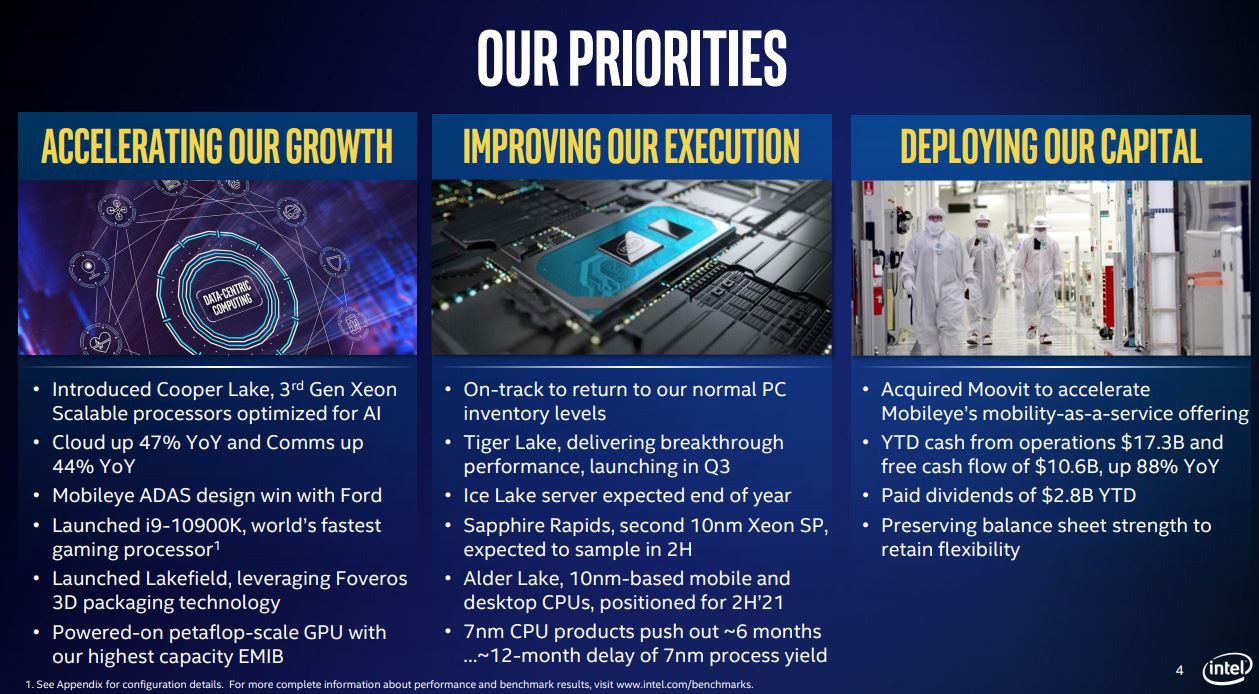Intel Says First 10nm Desktop CPUs Land in Second Half of 2021
Alder Lake-S is coming, but not soon
Intel's announcement today that its 7nm process will be delayed until late 2022 or early 2023 sent shockwaves through the industry, but the company also revealed that its first 10nm CPUs for the desktop won't come to market until the second half of 2021. AMD's continued push with its 7nm Ryzen processors has caught Intel flat footed as it continues to lose market share in the desktop PC market, so the relatively long wait for 10nm processors could prove to be a significant disadvantage for Intel.
Intel's Alder Lake-S chips are known to come with a hybrid architecture, meaning they will come with both a collection of larger and smaller cores much like ARM's big.LITTLE architecture. That means Alder Lake-S won't feature a traditional chip architecture, and even though Intel has paved the path with its Lakefield 3D processors, that approach presents challenges for both manufacturing and software support. It's unclear if Intel will use 3D packaging for the new chips, which could complicate the fabrication process.

The new chips will land in a new LGA1700 socket, and are also expected to use the new DDR5 specification. According to Intel's announcement today, we won't see the new chips until the second half of 2021. Intel's upcoming 14nm Rocket Lake processors will serve as the stopgap, but the company hasn't revealed when those chips will come to market.
Stay On the Cutting Edge: Get the Tom's Hardware Newsletter
Get Tom's Hardware's best news and in-depth reviews, straight to your inbox.

Paul Alcorn is the Managing Editor: News and Emerging Tech for Tom's Hardware US. He also writes news and reviews on CPUs, storage, and enterprise hardware.
-
InvalidError When Intel says one day that it is ramping down plans for 10nm in favor of fast-tracking 7nm, then 7nm trips over its feet, we get an announcement of probable 10nm desktop chips that haven't been on any roadmap I have seen before after it seemed like Intel's intent was to skip desktop straight to 7nm.Reply
Intel's senior management must be really sweating now, possibly two more years of being stuck in process quicksand. -
JayNor I've seen a few mentions of a Tiger Lake-H chip, which would be a 10nm part for desktop, using an beefed up power spec for a laptop chips. So, I doubt Alder Lake-S will be their first 10nm desktop chips, as this article states. Did Swan actually say that?Reply -
Makaveli I'm so confused with what Intel is doing.Reply
So we are going to see Rocket Lake somewhere between Q3-Q4 2020?
If you going launch a new arch by second half of 2021? -
watzupken Reply
Alder Lake is the first 10nm desktop part. Between now to Alder Lake launch, we have Comet Lake and Rocket Lake, both which are based on 14nm fab utilizing the existing 1200 socket.JayNor said:I've seen a few mentions of a Tiger Lake-H chip, which would be a 10nm part for desktop, using an beefed up power spec for a laptop chips. So, I doubt Alder Lake-S will be their first 10nm desktop chips, as this article states. Did Swan actually say that? -
watzupken Reply
With each trip up, they are extending their pain. So this 2 years of process quicksand may potentially become longer. If 7nm is indeed in trouble just as 10nm, then I presume it they may have to make compromises for it to work.InvalidError said:When Intel says one day that it is ramping down plans for 10nm in favor of fast-tracking 7nm, then 7nm trips over its feet, we get an announcement of probable 10nm desktop chips that haven't been on any roadmap I have seen before after it seemed like Intel's intent was to skip desktop straight to 7nm.
Intel's senior management must be really sweating now, possibly two more years of being stuck in process quicksand. -
D1v1n3D This is going to make AMD 4xxx even more juicy so long as they pull off better gaming performance than current Intel gen as next years 5xxx series will be 5nm so this means Intel wont have PCIe 4 or 5 gen anytime soon, goes the same for DDR5 support. GO AMD lol, I never liked Intel's tactics of business, now karma is catching up to them.Reply -
InvalidError Reply
10th-gen was supposed to get PCIe4 but Intel ran into unforeseen issues and had to postpone that to 11th-gen. Unless Intel has yet more unforeseen complications, LGA1200 should get PCIe4 for CPU-fed lanes when 11th-gen launches. Where PCIe5 is concerned, I'm skeptical about that making it to consumer-friendly motherboards any time soon due to how difficult maintaining signal integrity through a socket + PCIe or M.2 slot at 32Gbps is going to be.D1v1n3D said:this means Intel wont have PCIe 4 or 5 gen anytime soon -
TerryLaze ReplyAdmin said:Intel desperately needs 10nm CPUs to fend off AMD's increasing market share in the desktop PC market, but they aren't coming soon.
Intel Says First 10nm Desktop CPUs Land in Second Half of 2021 : Read moreAMD's continued push with its 7nm Ryzen processors has caught Intel flat footed as it continues to lose market share in the desktop PC market,
Any link to back this up?!?!
Maybe this should be spelled "in the "enthusiast" desktop PC market" ?
Which is a niche of a niche.
Because all we normal people have access to is intel's quarterly reports and there intel has doubled their net income in the last two years,so either they are selling the same amount of CPUs for double the price or their market share is way way way higher than anybody else's and they would have no issues with losing some of this doubled market share.